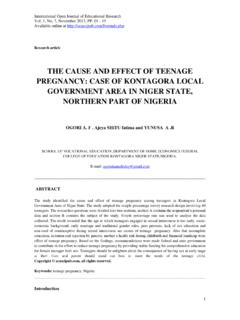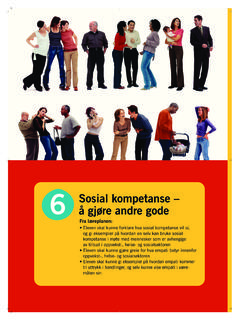Transcription of USER EDUCATION: ACADEMIC LIBRARIES - …
1 International Journal of Information Technology and Library Science Research Vol. 1, No. 1, April 2013, PP: 01- 06. Available online at Research Article USER EDUCATION: ACADEMIC LIBRARIES . Senthur Murugan E-mail: _____ ABSTRACT. This paper examines user education programmes in ACADEMIC library. This paper discussion focuses on the planning of user education, change in information services in ACADEMIC library, need for user education and implementation of these programmes and web based user education in ACADEMIC LIBRARIES and information technology user education programmes. Copyright , all right reserved.
2 KEY WORDS: User education, ACADEMIC library, web technology, information technology etc. _____. 1. INTRODUCTION. ACADEMIC LIBRARIES are at a turning point. Historically, college and university LIBRARIES were the natural destination for students, faculty, staff, and researchers seeking information. These users came to the library by default. ACADEMIC LIBRARIES served as the repository for published information as well as the intermediary for acquiring material from the outside world. 2. DEFINITION OF ACADEMIC LIBRARY. An ACADEMIC library is a library which serves an institution of higher learning, such as a college or a university LIBRARIES in secondary and primary schools are called school LIBRARIES .
3 These LIBRARIES serve two complementary purposes: to support the school's curriculum, and to support the research of the university faculty and students. The support of teaching requires material for class readings, and for student papers. In the past, the material for class readings, intended to supplement lectures as prescribed by the instructor, has been called reserves. In the period before electronic resources became available, the reserves were supplied as actual books or as photocopies of appropriate journal articles. Traditionally, one copy of a book was made available for 1 International Journal of Information Technology and Library Science Research Vol.
4 1, No. 1, April 2013, PP: 01- 06. Available online at each 10 students this is practical for large classes only if paperback copies are available, and the books reused from term to term. ACADEMIC LIBRARIES must decide what focus they take in collecting materials since no single library can supply everything. When there are particular areas of specialization in ACADEMIC LIBRARIES these are often referred to as niche collections. These collections are often the basis of a special collection department and may include original papers, artwork, and artifacts written or created by a single author or about a specific subject.
5 An ACADEMIC library is defined in the Instructions section of the survey form as an entity in a postsecondary institution that provides all of the following: 1. An organized collection of printed or other materials, or a combination thereof. 2. A staff trained to provide and interpret such materials as required to meet the informational, cultural, recreational, or educational needs of clientele. 3. An established schedule in which services of the staff are available to clientele. 4. The physical facilities necessary to support such a collection, staff, and schedule. This definition includes LIBRARIES that are part of learning resource centers.
6 Branch and independent LIBRARIES are defined as auxiliary library service outlets with quarters separate from the central library that houses the basic collection. The central library administers the branches. LIBRARIES on branch campuses that have separate NCES identification numbers are reported as separate LIBRARIES . 3. SOLUTION HIGHLIGHTS FOR ACADEMIC LIBRARIES : Comprehensive applications including an integrated library system, information portal and federated search application, Open URL Resolver, e-resources management and statistical analysis portal Inherent scalability and flexibility to manage metadata, collections in multiple formats, multiple databases and multiple locations Support for standard data formats and protocols such as MARC21, Uni MARC, Dublin Core, CDWA, XML, Dublin Core, Unicode, Open URL, OAI-PMH.
7 SRU/SRW and many others Electronic resources management including full interoperability with third-party systems and applications Web-based statistical portal to analyze trends and facilitate decision making Digital repository management to disseminate scholarly publications (support for the OAI harvesting protocol and repository upload). Multi-lingual support Support for Inter Library Loan (ILL). 2 International Journal of Information Technology and Library Science Research Vol. 1, No. 1, April 2013, PP: 01- 06. Available online at Course and resource management including integration with Virtual Learning Environments (VLEs), CRM applications and data harvesting environments using Web Service-based Service Oriented Architecture ( SOA).
8 Support for stack requests Interoperability with RFID and self-check systems Highly flexible search and resource discovery environment with federated searching, Open URL. linking and a graphical Web OPAC including enhanced content Information delivery functionality for users to receive customized information in the right place at the right time (SDI, RSS news feeds, journal availability and more). Web OPAC Reading Lounges' to provide students access to course materials in reading lists 4. THE CHALLENGE IN INFORMATION SERVICES. Information has become more complex and expensive. Organizations that furnish investment and other types of information, such as information that helps a firm monitor its cash position.
9 Agency or department responsible for providing processed or published information on specific topics to an organizations internal user, its customers, or the general public. In this context, the basic challenge is to convince and convert traditional users into users of Internet-based resources and services. The aim of information literacy is to make information users capable of locating, retrieving, and using information. Information literacy can contribute to developing information technology (IT) related competencies among end-users as it includes basic computer and network literacy.
10 5. USER EDUCATION HAS BEEN DEFINED AS. Instruction which equips library users with the skills to enable them to be independent and sophisticated users of LIBRARIES and their resources. all the activities involved in teaching users how to make the best possible use of library resources, services and facilities, including formal and informal instruction delivered by a librarian or other staff member one-on- one- or in a group 6. NEED FOR USER EDUCATION. Tremendous increase in the volume of publication as well as the resulting complexity of LIBRARIES and the methods by which literature is organized and disseminated necessitate the user education.

